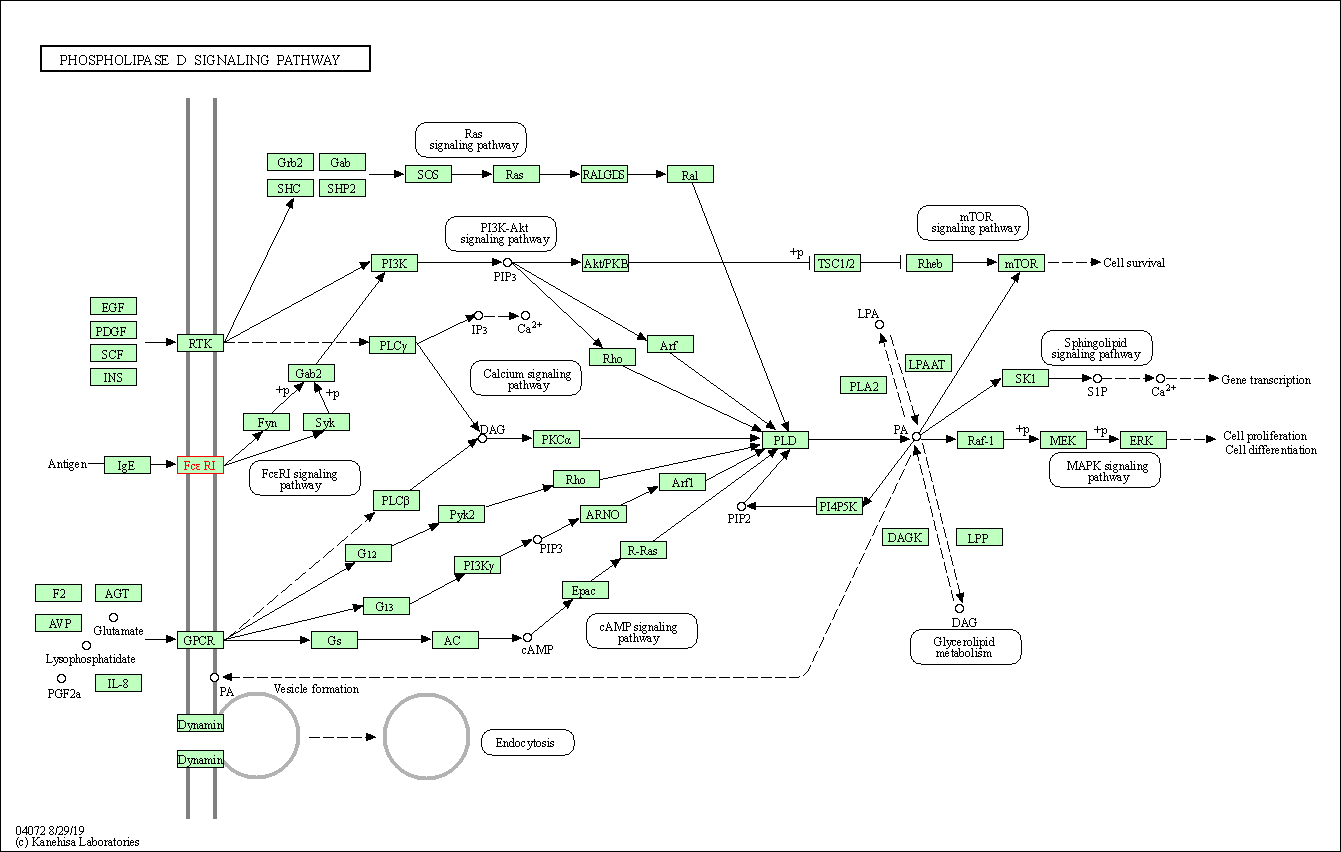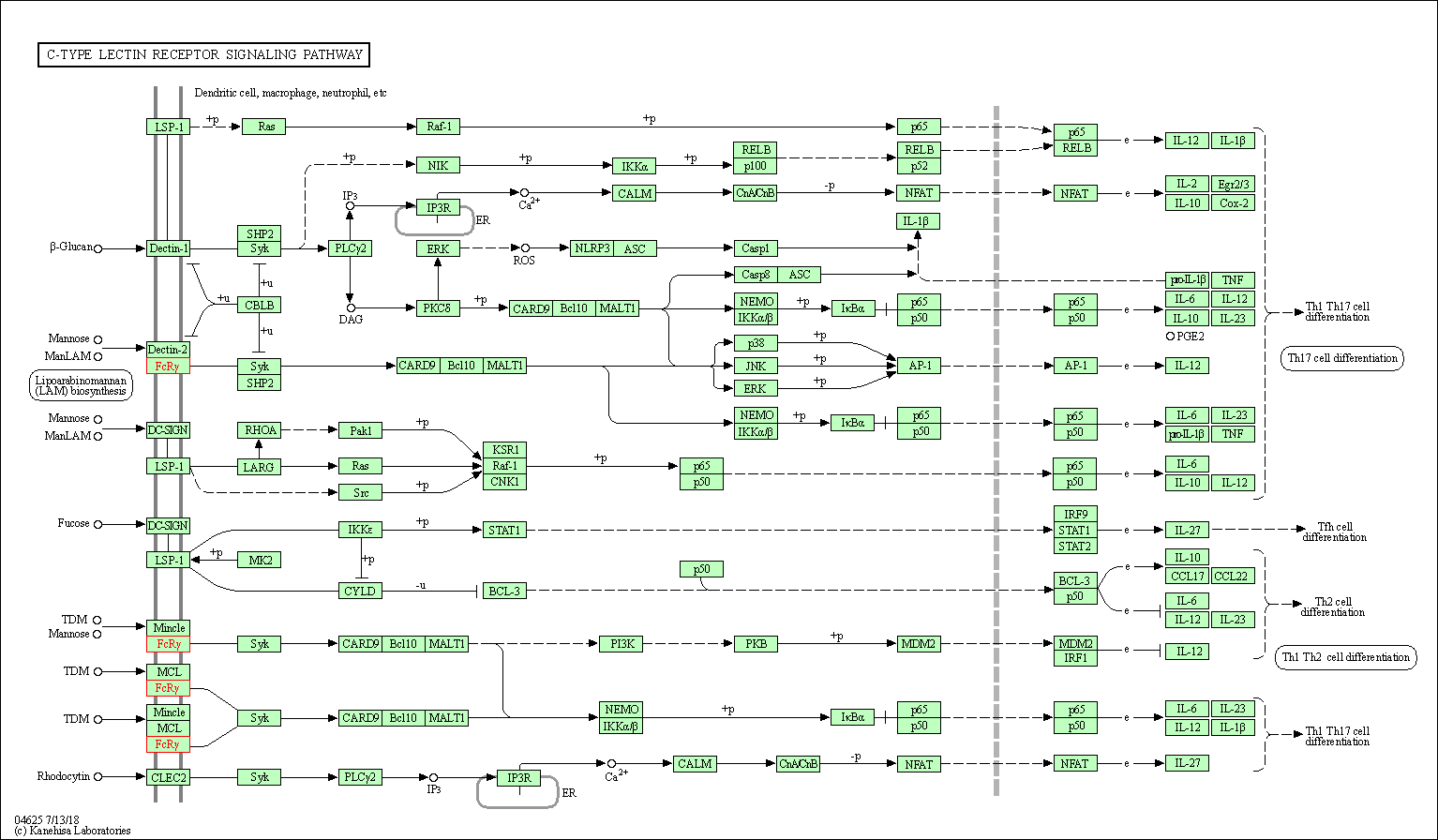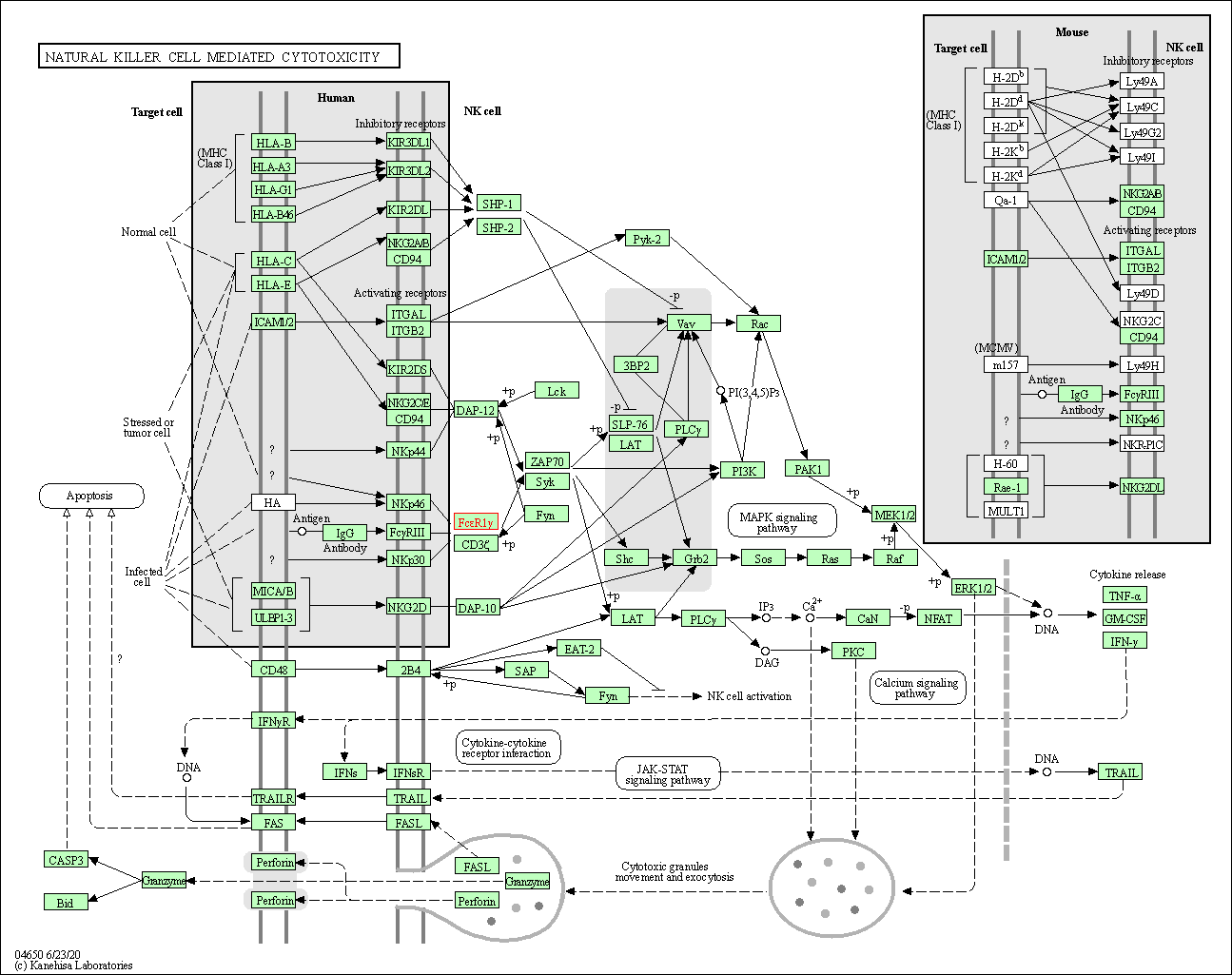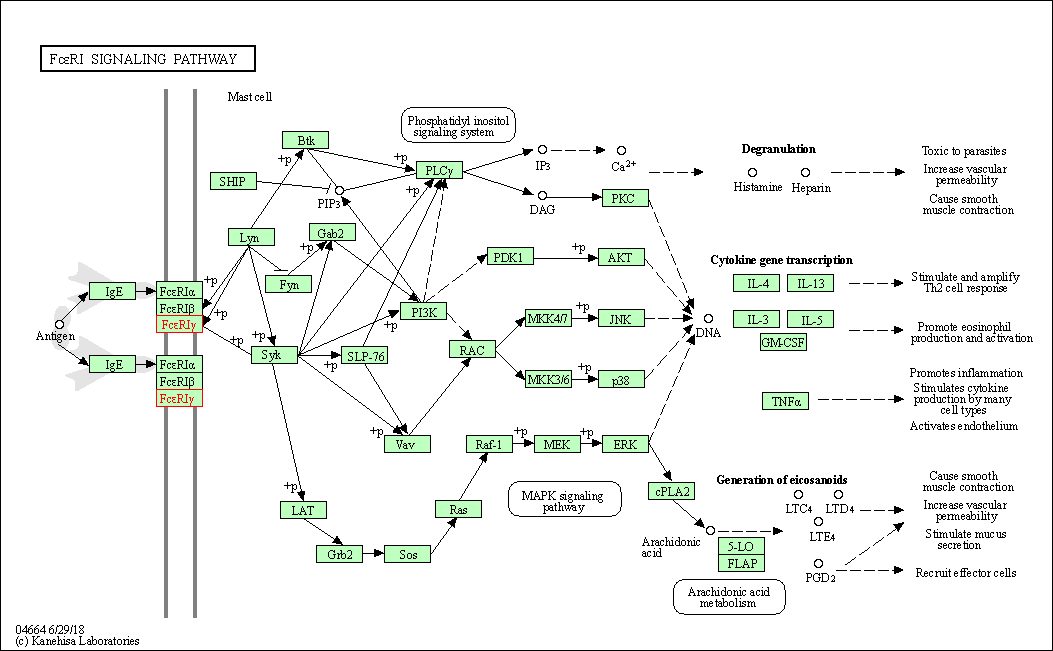Target Information
| Target General Information | Top | |||||
|---|---|---|---|---|---|---|
| Target ID |
T95400
(Former ID: TTDS00484)
|
|||||
| Target Name |
Immunoglobulin epsilon Fc receptor gamma (FCERG)
|
|||||
| Synonyms |
IgE Fc receptor subunit gamma; High affinity immunoglobulin epsilon receptor subunit gamma; FceRI gamma; FcRgamma; Fc receptor gamma-chain
Click to Show/Hide
|
|||||
| Gene Name |
FCER1G
|
|||||
| Target Type |
Successful target
|
[1] | ||||
| Disease | [+] 2 Target-related Diseases | + | ||||
| 1 | Asthma [ICD-11: CA23] | |||||
| 2 | Bacterial infection [ICD-11: 1A00-1C4Z] | |||||
| Function |
As a component of the high-affinity immunoglobulin E (IgE) receptor, mediates allergic inflammatory signaling in mast cells. As a constitutive component of interleukin-3 receptor complex, selectively mediates interleukin 4/IL4 production by basophils, priming T-cells toward effector T-helper 2 subset. Associates with pattern recognition receptors CLEC4D and CLEC4E to form a functional signaling complex in myeloid cells. Binding of mycobacterial trehalose 6,6'-dimycolate (TDM) to this receptor complex leads to phosphorylation of ITAM, triggering activation of SYK, CARD9 and NF-kappa-B, consequently driving maturation of antigen-presenting cells and shaping antigen-specific priming of T-cells toward effector T-helper 1 and T-helper 17 cell subtypes. May function cooperatively with other activating receptors. Functionally linked to integrin beta-2/ITGB2-mediated neutrophil activation. Also involved in integrin alpha-2/ITGA2-mediated platelet activation. Adapter protein containing an immunoreceptor tyrosine-based activation motif (ITAM) that transduces activation signals from various immunoreceptors.
Click to Show/Hide
|
|||||
| BioChemical Class |
Immunoglobulin
|
|||||
| UniProt ID | ||||||
| Sequence |
MIPAVVLLLLLLVEQAAALGEPQLCYILDAILFLYGIVLTLLYCRLKIQVRKAAITSYEK
SDGVYTGLSTRNQETYETLKHEKPPQ Click to Show/Hide
|
|||||
| 3D Structure | Click to Show 3D Structure of This Target | AlphaFold | ||||
| HIT2.0 ID | T67CB6 | |||||
| Drugs and Modes of Action | Top | |||||
|---|---|---|---|---|---|---|
| Approved Drug(s) | [+] 2 Approved Drugs | + | ||||
| 1 | Benzylpenicilloyl Polylysine | Drug Info | Approved | Bacterial infection | [2], [3] | |
| 2 | Omalizumab | Drug Info | Approved | Asthma | [4], [5], [6], [7] | |
| Mode of Action | [+] 3 Modes of Action | + | ||||
| Binder | [+] 1 Binder drugs | + | ||||
| 1 | Benzylpenicilloyl Polylysine | Drug Info | [1] | |||
| Modulator | [+] 1 Modulator drugs | + | ||||
| 1 | Omalizumab | Drug Info | [8] | |||
| Inhibitor | [+] 2 Inhibitor drugs | + | ||||
| 1 | Alpha-D-Mannose | Drug Info | [9] | |||
| 2 | Fucose | Drug Info | [9] | |||
| Cell-based Target Expression Variations | Top | |||||
|---|---|---|---|---|---|---|
| Cell-based Target Expression Variations | ||||||
| Different Human System Profiles of Target | Top |
|---|---|
|
Human Similarity Proteins
of target is determined by comparing the sequence similarity of all human proteins with the target based on BLAST. The similarity proteins for a target are defined as the proteins with E-value < 0.005 and outside the protein families of the target.
A target that has fewer human similarity proteins outside its family is commonly regarded to possess a greater capacity to avoid undesired interactions and thus increase the possibility of finding successful drugs
(Brief Bioinform, 21: 649-662, 2020).
Human Tissue Distribution
of target is determined from a proteomics study that quantified more than 12,000 genes across 32 normal human tissues. Tissue Specificity (TS) score was used to define the enrichment of target across tissues.
The distribution of targets among different tissues or organs need to be taken into consideration when assessing the target druggability, as it is generally accepted that the wider the target distribution, the greater the concern over potential adverse effects
(Nat Rev Drug Discov, 20: 64-81, 2021).
Human Pathway Affiliation
of target is determined by the life-essential pathways provided on KEGG database. The target-affiliated pathways were defined based on the following two criteria (a) the pathways of the studied target should be life-essential for both healthy individuals and patients, and (b) the studied target should occupy an upstream position in the pathways and therefore had the ability to regulate biological function.
Targets involved in a fewer pathways have greater likelihood to be successfully developed, while those associated with more human pathways increase the chance of undesirable interferences with other human processes
(Pharmacol Rev, 58: 259-279, 2006).
Biological Network Descriptors
of target is determined based on a human protein-protein interactions (PPI) network consisting of 9,309 proteins and 52,713 PPIs, which were with a high confidence score of ≥ 0.95 collected from STRING database.
The network properties of targets based on protein-protein interactions (PPIs) have been widely adopted for the assessment of target’s druggability. Proteins with high node degree tend to have a high impact on network function through multiple interactions, while proteins with high betweenness centrality are regarded to be central for communication in interaction networks and regulate the flow of signaling information
(Front Pharmacol, 9, 1245, 2018;
Curr Opin Struct Biol. 44:134-142, 2017).
Human Similarity Proteins
Human Tissue Distribution
Human Pathway Affiliation
Biological Network Descriptors
|
|
|
There is no similarity protein (E value < 0.005) for this target
|
|
Note:
If a protein has TS (tissue specficity) scores at least in one tissue >= 2.5, this protein is called tissue-enriched (including tissue-enriched-but-not-specific and tissue-specific). In the plots, the vertical lines are at thresholds 2.5 and 4.
|
| KEGG Pathway | Pathway ID | Affiliated Target | Pathway Map |
|---|---|---|---|
| Sphingolipid signaling pathway | hsa04071 | Affiliated Target |

|
| Class: Environmental Information Processing => Signal transduction | Pathway Hierarchy | ||
| Phospholipase D signaling pathway | hsa04072 | Affiliated Target |

|
| Class: Environmental Information Processing => Signal transduction | Pathway Hierarchy | ||
| Platelet activation | hsa04611 | Affiliated Target |

|
| Class: Organismal Systems => Immune system | Pathway Hierarchy | ||
| C-type lectin receptor signaling pathway | hsa04625 | Affiliated Target |

|
| Class: Organismal Systems => Immune system | Pathway Hierarchy | ||
| Natural killer cell mediated cytotoxicity | hsa04650 | Affiliated Target |

|
| Class: Organismal Systems => Immune system | Pathway Hierarchy | ||
| Fc epsilon RI signaling pathway | hsa04664 | Affiliated Target |

|
| Class: Organismal Systems => Immune system | Pathway Hierarchy | ||
| Click to Show/Hide the Information of Affiliated Human Pathways | |||
| Degree | 16 | Degree centrality | 1.72E-03 | Betweenness centrality | 3.15E-04 |
|---|---|---|---|---|---|
| Closeness centrality | 2.18E-01 | Radiality | 1.38E+01 | Clustering coefficient | 2.08E-01 |
| Neighborhood connectivity | 2.18E+01 | Topological coefficient | 1.19E-01 | Eccentricity | 11 |
| Download | Click to Download the Full PPI Network of This Target | ||||
| Drug Property Profile of Target | Top | |
|---|---|---|
| (1) Molecular Weight (mw) based Drug Clustering | (2) Octanol/Water Partition Coefficient (xlogp) based Drug Clustering | |
|
|
||
| (3) Hydrogen Bond Donor Count (hbonddonor) based Drug Clustering | (4) Hydrogen Bond Acceptor Count (hbondacc) based Drug Clustering | |
|
|
||
| (5) Rotatable Bond Count (rotbonds) based Drug Clustering | (6) Topological Polar Surface Area (polararea) based Drug Clustering | |
|
|
||
| "RO5" indicates the cutoff set by lipinski's rule of five; "D123AB" colored in GREEN denotes the no violation of any cutoff in lipinski's rule of five; "D123AB" colored in PURPLE refers to the violation of only one cutoff in lipinski's rule of five; "D123AB" colored in BLACK represents the violation of more than one cutoffs in lipinski's rule of five | ||
| Target Regulators | Top | |||||
|---|---|---|---|---|---|---|
| Target-regulating microRNAs | ||||||
| Target Affiliated Biological Pathways | Top | |||||
|---|---|---|---|---|---|---|
| KEGG Pathway | [+] 3 KEGG Pathways | + | ||||
| 1 | Sphingolipid signaling pathway | |||||
| 2 | Fc epsilon RI signaling pathway | |||||
| 3 | Asthma | |||||
| Pathwhiz Pathway | [+] 1 Pathwhiz Pathways | + | ||||
| 1 | Fc Epsilon Receptor I Signaling in Mast Cells | |||||
| Reactome | [+] 5 Reactome Pathways | + | ||||
| 1 | Fc epsilon receptor (FCERI) signaling | |||||
| 2 | Role of LAT2/NTAL/LAB on calcium mobilization | |||||
| 3 | FCERI mediated MAPK activation | |||||
| 4 | FCERI mediated Ca+2 mobilization | |||||
| 5 | FCERI mediated NF-kB activation | |||||
| WikiPathways | [+] 2 WikiPathways | + | ||||
| 1 | IL1 and megakaryotyces in obesity | |||||
| 2 | Fc epsilon receptor (FCERI) signaling | |||||
| References | Top | |||||
|---|---|---|---|---|---|---|
| REF 1 | Penicillin allergy: anti-penicillin IgE antibodies and immediate hypersensitivity skin reactions employing major and minor determinants of penicillin. Arch Dis Child. 1980 Nov;55(11):857-60. | |||||
| REF 2 | Drug information of Benzylpenicilloyl Polylysine, 2008. eduDrugs. | |||||
| REF 3 | Drugs@FDA. U.S. Food and Drug Administration. U.S. Department of Health & Human Services. 2015 | |||||
| REF 4 | URL: http://www.guidetopharmacology.org Nucleic Acids Res. 2015 Oct 12. pii: gkv1037. The IUPHAR/BPS Guide to PHARMACOLOGY in 2016: towards curated quantitative interactions between 1300 protein targets and 6000 ligands. (Ligand id: 6890). | |||||
| REF 5 | Natural products as sources of new drugs over the last 25 years. J Nat Prod. 2007 Mar;70(3):461-77. | |||||
| REF 6 | ClinicalTrials.gov (NCT00546143) Safety and Tolerability of Omalizumab in Patients With Mild to Moderate Asthma | |||||
| REF 7 | ClinicalTrials.gov (NCT01701583) Effect of Omalizumab (Xolair) on Basophils in Patients With Chronic Idiopathic Urticaria | |||||
| REF 8 | The potential of biologics for the treatment of asthma. Nat Rev Drug Discov. 2012 Dec;11(12):958-72. | |||||
| REF 9 | How many drug targets are there Nat Rev Drug Discov. 2006 Dec;5(12):993-6. | |||||
If You Find Any Error in Data or Bug in Web Service, Please Kindly Report It to Dr. Zhou and Dr. Zhang.

